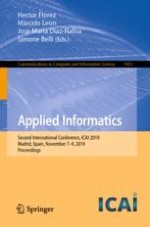2019 | Buch
Applied Informatics
Second International Conference, ICAI 2019, Madrid, Spain, November 7–9, 2019, Proceedings
herausgegeben von: Hector Florez, Marcelo Leon, Jose Maria Diaz-Nafria, Simone Belli
Verlag: Springer International Publishing
Buchreihe : Communications in Computer and Information Science
